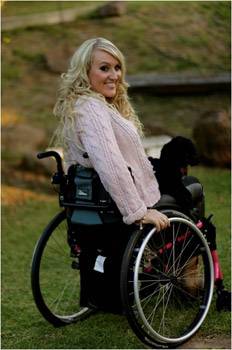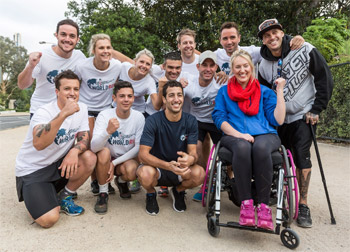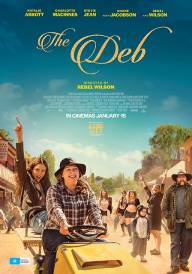Rhiannon Tracey The Wings for Life World Run Interview

Rhiannon Tracey The Wings for Life World Run Interview
The world's most unique and remarkable race, the Wings for Life World Run, is back in 2015 and will take place in six continents and 34 locations. On 3rd May 2015 at 11am UTC, 40,000 participants will set off at exactly the same time, regardless of their location, meaning some competitors will run from sundown to sunrise with others running from sunrise to sunset. Australian runners will start their race in Melbourne at 9pm AEST, running through the night and into the early morning.
The Wings for Life World Run was introduced to support the not-for-profit Wings for Life Foundation, which funds spinal cord research projects all over the world, with 100% of entry fees going directly to the foundation. In 2014, $4,380,000 was raised in Australia for the foundation –s a huge contribution to a worthwhile cause.
The Wings for Life World Run is all about the last man and woman standing to take out first place, fuelled by pure adrenalin. The very last Australian runner of the 2014 race, Dave Kennedy, completed a staggering 43.89km to finish in the top thirty in the world. His incredible feat added a significant amount to the 530,928 kilometres that were run in total. This is the equivalent of one runner completing more than 13 laps around the world.
Open to runners of all abilities, ages and nationalities, the Wings for Life World Run brings a set of extraordinary challenges to its competitors. Besides the hurdle of starting with thousands of participants at exactly the same time, thirty minutes after the start of the race a 'Catcher Car" begins to follow them. Instead of runners pursuing a finish line, the Catcher Car will be hot on their heels, and once a runner is passed by the 'Catcher Car", electronic sensors register the athlete's chips, meaning their race is over.
This year, Australia's race is moving to Melbourne, and will see Australian F1 driver Daniel Ricciardo joining the race equipped with start number 1, amongst a host of other Australian famous faces and sporting stars, in the aim to support the Wings for Life World Race and the Wings for Life Foundation.
The race features a series of breathtaking routes, some passing through deserts while others traverse some of the world's most beautiful country-sides and others follow scenic coastlines. This year, five new tracks have been added in Japan, Russia, Dubai, Denmark, and a second track in Germany.
Participants running the Wings for Life World Race are running for those who can't. Millions of people around the world are living with a spinal cord injury. Every year, at least 250,000 more sustain a traumatic spinal cord injury, following traffic accidents, tragic falls and slips.
Register now at www.wingsforlifeworldrun.com.
Interview with Rhiannon Tracey
Question: What is the Wings for Life World Run?
Rhiannon Tracey: The Wings for Life World Run is a global run with a difference. On 3rd May 2015, participants in six continents and 35 locations around the world will start the race at exactly the same time, with more than 40,000 runners already registered globally. Australian runners will kick off in Melbourne at 9pm AEST, running through the night and into the early morning.
Open to runners of all abilities, ages and nationalities, the run brings a set of extraordinary challenges to its competitors. Besides the hurdle of starting with thousands of participants at exactly the same time, it's the only race where the finish line catches you. Your race is over once you're overtaken by the -Catcher Car' that sets off 30 minutes after the start.
The Wings for Life World Run was introduced to support the not-for-profit Wings for Life Foundation, which funds spinal cord research projects all over the world, with 100% of entry fees going directly to the foundation.
Since 2004, Wings for Life has funded life-changing research projects and clinical trials around the globe. While the cure is still to be found, steady progress has been made.
Question: What is your goal for the Wings for Life World Run?
Rhiannon Tracey: My personal goal is to be able to push at least 3 kilometers on my own, but also to have as many people to join our team The Next Step SCI Recovery.
Question: Can you talk about the funds the Wings for Life World Run raises for spinal cord research projects globally?
Rhiannon Tracey: Raising money for spinal cord injury research is such a special initiative because you can get to see where your money is going physically. A cure will change so many lives and I think it is incredible that 100% of the registration fee from the Wings for Life World Run goes towards research.
 Question: Are you able to tell us your story?
Question: Are you able to tell us your story?
Rhiannon Tracey: In 2009 I sustained a Spinal Cord Injury after diving into a resort swimming pool in Bali. I instantly became a quadriplegic at the age of 20, and was told I would never feed myself again, nor walk again.
With these words drilled into my mind I embarked on a recovery journey, which continues to this day, that involves intense exercise therapy, as well as alternative therapies such as massage and acupuncture. I even took up horse riding post injury after researching the benefits!
Almost 6 years post I walk with the help of crutches, the injury is an ongoing battle but it's one I'm willing to continue to fight and fight for.
Without too much thought Spinal Cord Injury advocacy became my life after my injury, as it was so apparent to me that there were so many people with this injury and sustaining new ones that are just not given enough options for recovery, or to live a for filled life.
My point – Life does not end after having a spinal cord injury!
Question: Why is important for you to prove doctors wrong, daily?
Rhiannon Tracey: I think the power of a positive mind is something that can get a person through the most difficult of times, and I for one have had a few, and walking again for me was the most important thing when I sustained my injury. But what I soon learnt was that recovery was far greater than just walking. It is about being able to find a way to do the things you enjoyed and that made you happy before you became injured. It's about regaining your independence or even being able to hug a loved one again. These are the little things most people take for granted.
Question: What's a typical day like, for you?
Rhiannon Tracey: A typical day is generally pulling my stiff body out of bed, and then tackling whatever the day throws at me. I try to get out of bed on a positive note so I try to stay away from technology until I've had my morning coffee and can function properly.
I'm generally greeted by my cat Garfield, by him jumping up on my lap and head butting me, and then I go outside and feed and play with my 3 dogs.
Nutrition is very important for me as I have really realised since participating in the exercise program at The Next Step SCI Recovery Centre, how important food is to fuel my body and keep me feeling good, so I always eat breakfast, whether it's a smoothie, muesli or yogurt.
I try to make my workouts at the center as early as physically possible so I can get moving and get it done.
I like to be at the centre to chat to and see what the other clients are achieving as it keeps me motivated, and I also help with the marketing and PR on a volunteer basis so I commit a bit of time to that each day keeping the website and social media updated.
I also dedicate time to go into the Royal Talbot Rehabilitation Centre and mentor and motivate newly injured patients and make them aware of their options once they leave hospital.
I try to have some down time in the evening after I have dinner so I can go to bed with a quiet mind as sleep comes as a struggle since having my injury, but when the option to have a nap is there, I won't pass it up!
Question: What is The Next Step Spinal Cord Injury Recovery & Wellness Centre?
Rhiannon Tracey: The Next Step is a not-for-profit organisation, which is designed to not only assist those personally affected, but also to support the community that is affected indirectly as well, such as family, friends and carers.
Question: How does The Next Step Spinal Cord Injury Recovery & Wellness Centre help people with spinal cord injuries?
Rhiannon Tracey: Not only does The Next Step Spinal Cord Injury Recovery & Wellness Centre offer exercise recovery programs, it also offers other proven modalities that assist in recovery such as massage therapy, acupuncture and naturopathy and mind and motivational training.
We treat the body as a whole and break it down to focus on the areas that need vast improvement whether that be physically or mentally.
These services are not only available to the individual with the injury but also to the family and support networks to help create a positive circle for the greatest recovery potential.
Question: Why is it important to you to mentor and motivate others living with spinal cord injuries?
Rhiannon Tracey: When I first had my injury there were not really many people willing to come and discuss their experiences with me, which was incredibly frustrating. Although I had a great support network, for me I just needed to hear what others in my situation had gone through without sugar coating anything.
The good, the bad and the ugly, but most importantly, I needed to know there was a light at the end of the tunnel.
That life didn't have to end here and that if I took back control of my body, I could help it recover.
I want people to be aware of these options. To be given the opportunity to have a happy life again so they too can share their stories to someone else that needs a bit of inspiration.
Question: What's your next goal?
Rhiannon Tracey: It's really funny because I've finally got to a place where my physical goals have come to a halt because there is not much I can't do now apart from walking long distances which honestly does seem like a huge priority anymore.
Interview by Brooke Hunter
MORE





